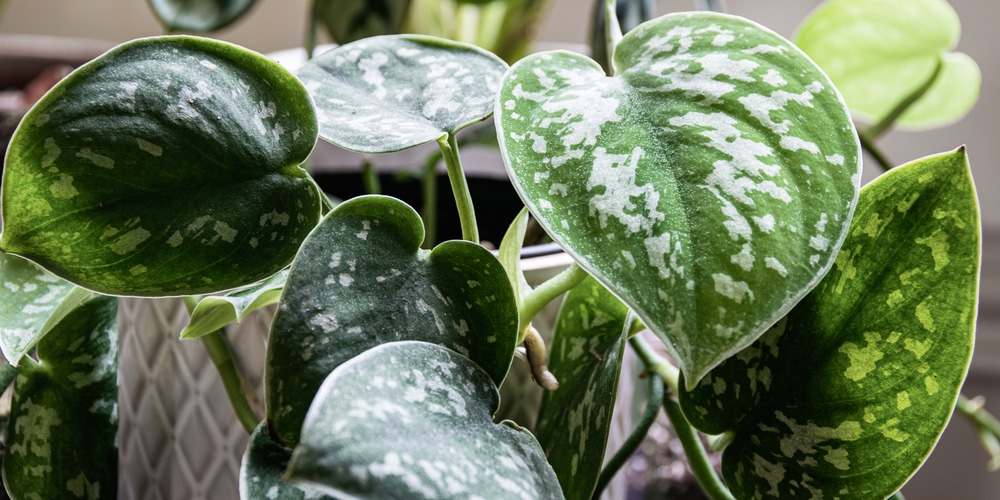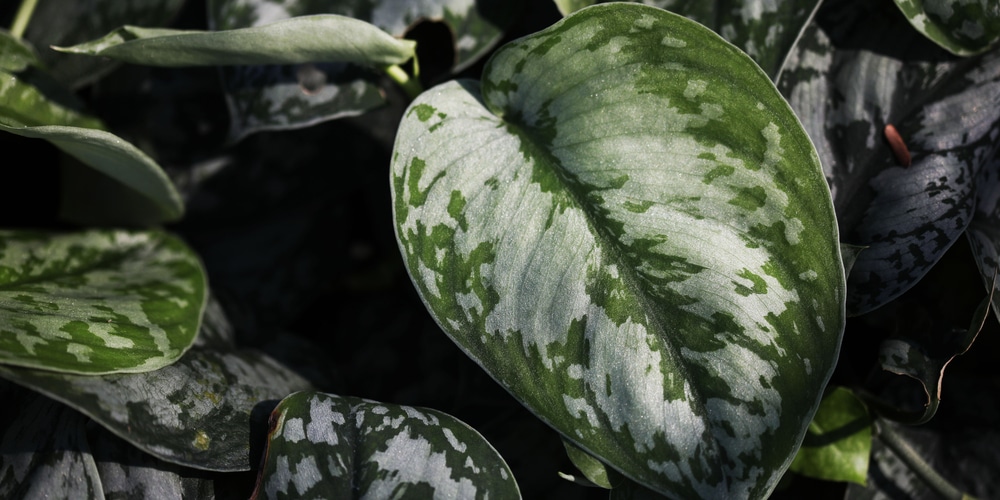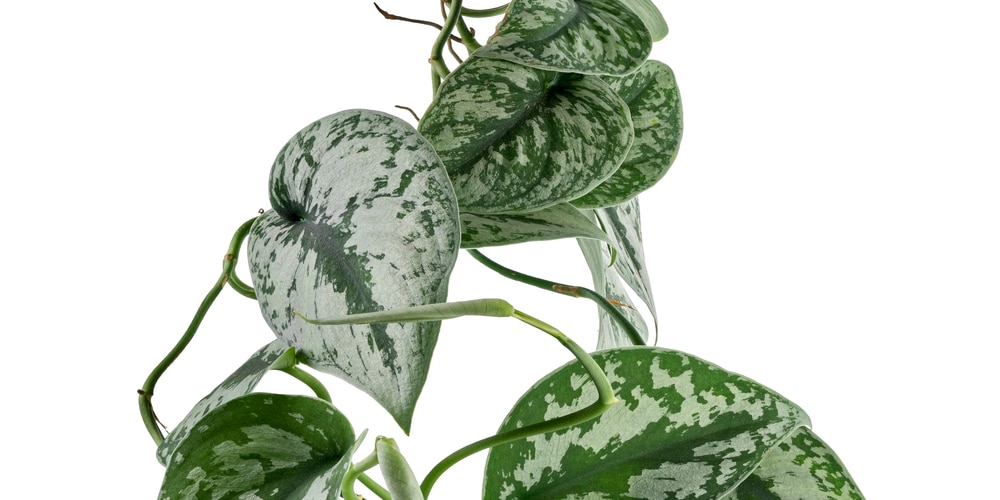Satin Pothos is a very hardy houseplant that’s commonly called Devils Ivy. These plants look great as they have heart-shaped leaves and are one of the most easy-to-care-for indoor plants around.
Satin Pothos can be grown outside in a flower bed or container year-round in USDA zones 10 or 11. In other areas, the plant is commonly grown as a houseplant. Let’s look at how to grow and care for a Satin Pothos plant. It’s also extremely low maintenance; in short, it’s almost impossible to mess up caring for this plant!
What is a Satin Pothos?
Satin Pothos is a climbing vine with heart-shaped leaves. This plant has a unique appearance as it has variegated leaves with a speckled appearance. The leaves are green and cream-colored and look very eye-catching.
The Satin Pothos is part of the Araceae family and has the botanical name Scindapsus pictus. In the wild, they’re native to Eastern Asia, from India to China. In those regions, they can be found growing on trees in thick forests as an epiphyte. The plants use the tree as a means of support but don’t steal any nutrients or water from it. In its natural habitat, Satin Pothos will grow 30 feet tall or more. However, you’ll rarely see them stretch beyond 12 feet indoors due to artificial light and less soil in which to spread their roots.
They make excellent hanging plants, as they happily cling to structures such as wood, wire, or anything else they can securely fasten themselves to. Satin Pothos is poisonous to pets and humans. Keep pothos out of the reach of small children and pets such as dogs and cats. Satin pothos can be grown outdoors in zones 10 and 11.
How to Care for a Satin Pothos?
Satin pothos is easy to care for and are the perfect tropical plant for beginners. They thrive in warm, humid environments and require regular watering. Just follow these tips to grow a healthy specimen in your home or yard:
Sunlight needs
You’ll need a place with a good amount of sunlight to grow your pothos. They prefer bright, indirect light, but they can adapt to partial shade too. Don’t leave your plant in the full sun as they can suffer from sunburn.
Watering Requirements
Give your plant a drink whenever the soil feels dry an inch below the surface. Watering frequency is determined by how quickly moisture evaporates from the top inches of soil, so keep an eye on it and water when necessary, rather than following a strict weekly or monthly schedule. These plants are fairly drought tolerant but shouldn’t be neglected.
Soil Mix
If possible, use a peat-based soil mix, or add perlite or peat moss to standard houseplant soil. These types of soil mixes are naturally acidic and will help keep your pothos healthy. Good potting soils include those with peat moss, pine bark, composted organic matter, and sedge peat. Avoid “potting soil,” which is sterilized garden dirt, and steer clear of chemical-laden commercial brands. Pothos thrive in soil with a pH range of between 6.1 and 6.5, although they can adapt to slightly higher or lower ranges. The most important thing is that the soil is loose and well-draining to prevent root rot. You can add some stones or gravel to the bottom of the pot to help with drainage.
Humidity
Satin Pothos enjoy some humidity as they are tropical plants. If conditions are too dry, your plant will be unhappy, and the leaves may feel dry and brittle. This problem can be solved by lightly misting your plant, using a humidifier, or placing a water and pebble tray under your plant.
Alternatively, place your plant in the kitchen or bathroom as these rooms are naturally higher in humidity. You can also group tropical plants to increase humidity in the surrounding area.
Light Requirements
Your pothos will appreciate bright but indirect sunlight, such as what it would receive under a south-facing window with light shade from trees, etc. Avoid direct afternoon sun, which can scorch leaves. Sunburn will show up as dry, brown spots on your plant’s leaves. This is not only unsightly but will also weaken your plant.
Temperature
Your pothos will be happy as long as you keep temperatures above fifty degrees F. Don’t expose this plant to freezing temperatures or draughts, which can kill it quickly.
Fertilization
If your pothos is in a good potting mix, you probably won’t need to worry about fertilizing them very often. The soil should contain everything your plant needs. However, it may be beneficial to provide a well-balanced liquid fertilizer at half strength during the growing season.
Pests
Pothos can be affected by sap-sucking insects such as aphids, mealybugs, and spider mites. If your plant is attacked by bugs, simply catch the culprits with a plastic cup or jar. You can also remove your plant and place it in quarantine in another room temporarily so that other houseplants aren’t affected. Wash your plant down well using a shower after removing the pests. This will help eliminate any lingering insects or eggs. If this doesn’t work, you can try using neem oil or insecticidal soap.
How to propagate Satin Pothos?
The Satin Pothos is one of the easiest plants to propagate. To propagate your pothos, simply cut or pinch off any unwanted shoots and stick them in some moist potting mix. They’ll quickly take root, and you’ll be growing a new plant in no time!
When choosing which stems to propagate, select ones that look healthy rather than dead or damaged. Only propagate from a mature plant and take cuttings using a sterilized pair of scissors or knife to stop the spread of bacteria.
Conclusion
Satin Pothos makes a fabulous gift for anyone interested in indoor plants. They are beautiful tropical plants that have lovely foliage and look great in a home or office environment. Beginners especially will love this beautiful, easy-to-grow specimen. Just be sure that the person you’re giving it to is aware of the plant’s poisonous nature.


